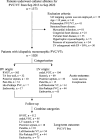Outcomes of single-procedure radiofrequency catheter ablation for idiopathic ventricular arrhythmias: a single-centre retrospective cohort study
- PMID: 38382956
- PMCID: PMC10882318
- DOI: 10.1136/bmjopen-2023-081815
Outcomes of single-procedure radiofrequency catheter ablation for idiopathic ventricular arrhythmias: a single-centre retrospective cohort study
Abstract
Objectives: Radiofrequency catheter ablation is the first-line treatment for idiopathic premature ventricular complexes (PVCs) and ventricular tachycardias (VTs). However, the outcomes were less compared among the categories. The study aims to assess the effectiveness and safety of catheter ablation for idiopathic PVC/VTs in a single high-volume centre, using the right ventricular outflow tract (RVOT) as a reference.
Design: Retrospective cohort study.
Setting: Patient data were collected from a tertiary hospital in Guizhou, China.
Participants: Between September 2013 and September 2022, 1028 patients (male: 41.3%; age: 46.5±15.6 years) who underwent the first catheter ablation for idiopathic monomorphic PVC/VTs were enrolled.
Outcome measures: Acute success, procedure-related complications, and long-term recurrence were assessed. Antiarrhythmic drugs (AADs) were not administrated after procedures unless recurrence was identified.
Results: The overall acute success rate was 90.3%, with 368 patients (35.8%) experiencing left ventricular PVC/VTs. No cases of third-degree atrioventricular block or death were reported. Complications were more common in patients with left ventricular PVC/VTs than those with right-sided ones (4.6% vs 0.1%, p<0.001). A total of 926 patients (90.1%) were followed up for an average of 9.7±3.7 months, and only the PVC/VTs category was found to be associated with long-term success rates. The RVOT, endocardial left ventricular outflow tract (endoLVOT), tricuspid annulus (TA) free wall, posterior septum and fascicular VT had long-term success rates exceeding 85%. Other types of PVC/VTs showed significantly higher risks of recurrence.
Conclusions: Besides RVOT and fascicular VT, single-procedure catheter ablation without AADs is highly effective for endoLVOT, TA-free wall and posterior septum. Patients with left ventricular PVC/VTs have higher complication risks compared with right ones.
Keywords: Cardiac Epidemiology; Cardiology; Pacing & electrophysiology.
© Author(s) (or their employer(s)) 2024. Re-use permitted under CC BY-NC. No commercial re-use. See rights and permissions. Published by BMJ.
Conflict of interest statement
Competing interests: None declared.
Figures



Similar articles
-
Clinical usefulness of a multielectrode basket catheter for idiopathic ventricular tachycardia originating from right ventricular outflow tract.J Cardiovasc Electrophysiol. 2001 May;12(5):511-7. doi: 10.1046/j.1540-8167.2001.00511.x. J Cardiovasc Electrophysiol. 2001. PMID: 11386509
-
Idiopathic monomorphic ventricular tachycardia: clinical outcome, electrophysiologic characteristics and long-term results of catheter ablation.Int J Cardiol. 1997 Nov 20;62(2):143-50. doi: 10.1016/s0167-5273(97)00198-8. Int J Cardiol. 1997. PMID: 9431865 Clinical Trial.
-
Prospective use of ablation index for the ablation of right ventricle outflow tract premature ventricular contractions: a proof of concept study.Europace. 2021 Jan 27;23(1):91-98. doi: 10.1093/europace/euaa228. Europace. 2021. PMID: 33063099
-
Are antiarrhythmic agents indicated in premature ventricular complex-induced cardiomyopathy and when?J Cardiovasc Electrophysiol. 2024 Mar;35(3):574-582. doi: 10.1111/jce.16055. Epub 2023 Sep 7. J Cardiovasc Electrophysiol. 2024. PMID: 37676022 Review.
-
Conventional mapping and ablation of focal ventricular tachycardias in the healthy heart.Herzschrittmacherther Elektrophysiol. 2017 Jun;28(2):187-192. doi: 10.1007/s00399-017-0505-3. Epub 2017 May 8. Herzschrittmacherther Elektrophysiol. 2017. PMID: 28484842 Review. English.
Cited by
-
Predictive value of surface electrocardiogram in localizing right ventricular outflow tract premature beats: a study combining intracardiac echocardiography and electroanatomical mapping under all-zero fluoroscopy ablation.Front Physiol. 2025 Jun 19;16:1610974. doi: 10.3389/fphys.2025.1610974. eCollection 2025. Front Physiol. 2025. PMID: 40613046 Free PMC article.
References
-
- Al-Khatib SM, Stevenson WG, Ackerman MJ, et al. . 2017 AHA/ACC/HRS guideline for management of patients with ventricular arrhythmias and the prevention of sudden cardiac death: executive summary: a report of the American college of cardiology/American heart association task force on clinical practice guidelines and the heart rhythm society. Circulation 2018;138:e210–71. 10.1161/CIR.0000000000000548 - DOI - PubMed
Publication types
MeSH terms
Substances
LinkOut - more resources
Full Text Sources
Other Literature Sources
